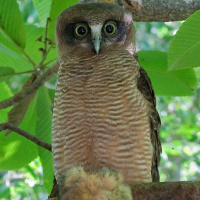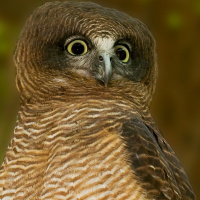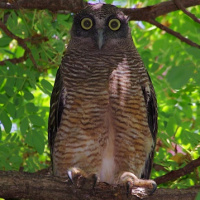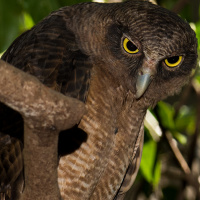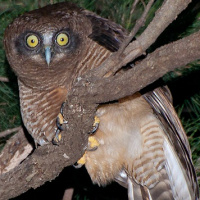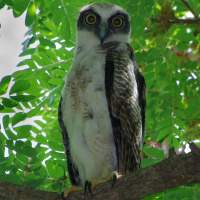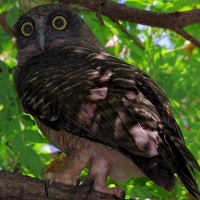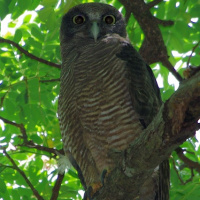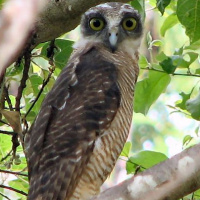Introduction
The Rufous Owl is a large, rufous-coloured owl with no ear-tufts.
Photo Gallery (9 pictures)
Sound Gallery
Information
Description: The forehead, crown, nape, mantle and back are dark rufous, densely marked with pale narrow bars. There is a large
blackish-brown zone with a slight rufous tint around the eyes, which are bright yellow. The cere is pale bluish-grey and the bill pale bluish-horn.
The wing-coverts and scapulars are mottled dark rufous and ochre-buff to pale brown, with the feathers narrowly edged pale brownish-buff. The primaries and
secondaries are dark rufous-brown, barred pale brown. The slightly wedge-shaped tail is dark rufous-brown, and barred pale brown.
Underparts from the throat to the belly are densely barred rich rufous or cinnamon and buffish-cream.
Tarsi are feathered rufous to the base of the toes, which are dirty yellowish in colour. Claws are dark horn with blackish tips.
Size: Length 40-57cm. Wing length 260-383mm. Tail length 180-228mm. Weight 700-1300g. Males are larger and heavier than females, which is unusual for owls.
Habits: A shy and elusive bird. Generally nocturnal, roosts during the day, singly on in pairs, in thickly foliaged mature trees with a good view of the surroundings. Will defend the nest very aggressively.
Voice: Rufous Owls are not very vocal, and call very little outside the breeding season. Pairs at roost may converse very softly. The commonest call is a deep, double hoot, similar in pitch and tempo to the Powerful Owl but more nasal, less ringing and with far less carrying power. A second note may be at same or a slightly higher pitch than the first. Female's calls are always slightly higher. Occasionally a single hoot may be used. The female has sheep-like bleating call similar to the Powerful Owl used when the male returns to the nest with food.
Hunting & Food: The Rufous Owl is an extremely versatile and powerful hunter taking a variety of prey from beetles to large birds and flying foxes. Prey recorded include Brush-turkey, Scrubfowl, Papuan Frogmouth, Blue-winged Kookaburra, White Cockatoo, flying fox, Sugar Glider, beetles, phasmids, several species of heron, ducks, parrots and, remarkably, crayfish. Prey have been seen to be taken from perches (Scrubfowl), by snatching from foliage in flight (phasmids), in aerial chases (flying fox) and by hawking like a giant flycatcher (beetles). The crayfish were presumably taken when stranded by falling floodwater.
Breeding: The Rufous Owl has a regular breeding season with egg laying varying from June in the Northern Territory to September in north-east Queensland. Individual females appear to lay at very much the same date each year. The presence of the previous seasons young may sometimes inhibit nesting for that season. As nesting approaches, both birds roost close together, often on the same branch. After dark, the male calls with a double hoot and the female may fly to him with excited bleating trills. Pairs perch side by side and the male preens the nape of the female's neck while she picks at his toes with her bill. Both sexes may be fiercely aggressive to humans in defense of the nest, which is a large hollow in the trunk or a main limb of a big tree, usually living but sometimes dead. Most nests are high, at about 30 metres, but occasionally low at down to less than 3 metres. The male cleans out the hollow and female only enters immediately before laying 2 (or occasionally 1) eggs. There are 3 days in between laying the dull white, almost spherical eggs. They are 49-54mm x 44-48mm. Incubation is 37 days and the Young have a first and second whitish down. Fledging is about 50 days while still partly downy. The young remain dependent on adults for several months and this period may extend into the next breeding season.
Habitat: Rainforests, monsoon forest; wet, forested gullies, and adjoining woodland.
Distribution: Patchy distribution across northern Australia - northern Western Australia, Northern Territory and Queensland. Also in northeast Queensland. Also found in New Guinea and the Aru Islands.

Range of the Rufous Owl Ninox rufa
Status: Rare to very uncommon depending on location. Listed as 'Least Concern' by Birdlife International.
Original Description: Gould, John. 1846. Proceedings of the Zoological Society of London (PZS): Pt.14, no. 156, p. 18.

